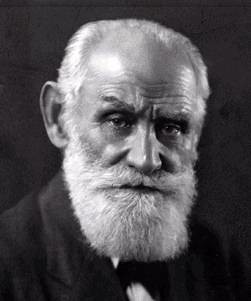What is Classical Conditioning?
In an article by A. Dickinson and N.J. Mackintosh they define classical conditioning as "arranging a relationship between certain events in the subjects environment, and, we assume, the subject comes to associate those events together."
History
Classical Conditioning was discovered around the beginning of the 20th Century by a Russian physiologist Ivan Pavlov (Clark, 2004). Pavlov was actually not experimenting with behaviorism, but instead he was studying the digestive process in dogs. He stumbled upon, and accidently discovered classical conditioning when he noticed that the dogs salivated before they received their food. The dogs even began to salivate at the sight of the lab assistants after the repeated pairing of the assistants and the food. Ivan Pavlov first called this “phenomena” as “psychic secretions” (Nobelprize.org). Years later, psychologists would come to know this as classical condion.Here is a video showing Pavlov's experiment:
Principles
There are many different principles of classical conditioning. Let’s use Pavlov’s experiment with the dogs for an example of each:
Before starting the conditioning, you start with a Neutral Stimulus (NS) that without the pairing, elicits no response.
- Pavlov used a tuning fork, which at first, did not elicit salivation in the dogs.
During classical conditioning you have to pair the Neutral Stimulus with an Unconditioned Stimulus (UCS). The time between the NS and the UCS is crucial. For optimal results you want to introduce the NS right before you present the UCS.
The NS and the UCS elicit the Unconditioned Response (UCR).
-Pavlov introduced the tuning fork and then presented the dog food. This led to dog salivating.
After conditioning the NS has become a Conditioned Stimulus (CS) that elicits the Conditioned Response (CR).
-After many pairings, Pavlov used the tuning fork without presenting any food, and the dog would salivate.
RECAP:
NS----> No response
NS + UCS----> UCR
Applying Classical Conditioning
Not only is classical conditioning a way to train house pets, like dogs or cats, but it also works on other animals too! Have you ever been to Sea World and have gone to any of their exhibits? Take the Shamu, or whale exhibit for example, that whale has more than likely been classically conditioned to do the tricks he is performing. You can go to the Sea World website and learn a lot more on how they train their animals, and even tips on how to train your pets. (http://www.seaworld.org/animal-info/info-books/training/animal-behavior-&-learning.htm)
Here is a video describing Classical Conditioning in training a horse:
You can even train a chicken to pick out the Queen of Hearts!
NS-->Click + UCS-->Food = UCR-->Queen of Hearts
CS-->Click/Food=CR-->Queen of Hearts
So, as you can see classical conditioning is very diverse with what you can do with it. From simply training your house pet to sit, to training killer whales to do flips, and getting a chicken to pick a certain card is possible with classical conditioning! All you need is a goal, an animal, and some patience!

